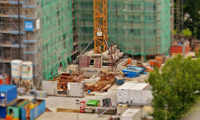 Two things that we often neglect when planning a new project: Terrain and climate.
Two things that we often neglect when planning a new project: Terrain and climate.
Oftentimes, a well-built home fails to last simply because it was built for a different kind of terrain, or a different kind of weather. A Spanish style California home, for instance, wouldn’t last a decade being bombarded with the heavy snow and ice of the Midwest. And you know those island homes built on stilts in case of flooding? Great idea for a humid climate with softer ground, but try that on a hillside in Arizona, and the slow shifting of the rock-hard surface is going to have that house teetering over to one side before the next presidential term is over.
If you have multiple degrees in engineering, architecture, geology and physics, then you might be able to build whatever you like on any terrain, in any climate, based strictly on your own knowledge. Unfortunately, most of us never had the opportunity to spend 24 years in college before going out into the workforce, so how do we find out how to go about building safe, sturdy, comfortable homes anywhere in the world?
The most effective way to determine how best to build in an area with which you’re not entirely familiar is to simply take a look around the older buildings in the neighborhood and take some notes. What materials do they use? Are they well-insulated or is that not a major consideration in this region? Is anyone building homes on the sides of hills, or do they prefer flat ground? Ask local homeowners and builders, find online forums for construction professionals in the neighborhood.
Some structures are pretty universal. You don’t need to do a week’s worth of research to build a tool shed or a warehouse. Utilitarian buildings aren’t meant to be cozy or easy on the eyes. Likewise, if you’re putting an additional room on the home, then simply matching it to the rest of the building will ensure that it lasts just as long. When your goals are a little more ambitious, when you’re trying to create a home that will make the client happy and look great in your portfolio, “when in Rome” is the motto of the day. If you don’t see any two story homes in the area, that’s probably for a reason. If you don’t see anyone building right by the lake, then shifting tides and muddy soil are probably a major concern.
By adapting to the techniques and materials used in the oldest homes in the same area, and avoiding borrowing any ideas from the team whose two story home toppled over and put their firm out of business last year, you get to “learn from the other guy’s mistakes,” and you can focus on just building a great home.





